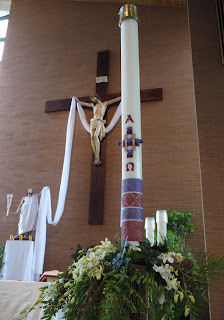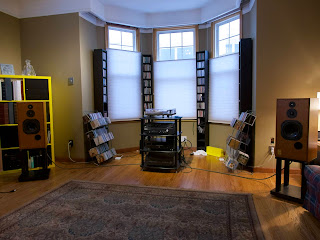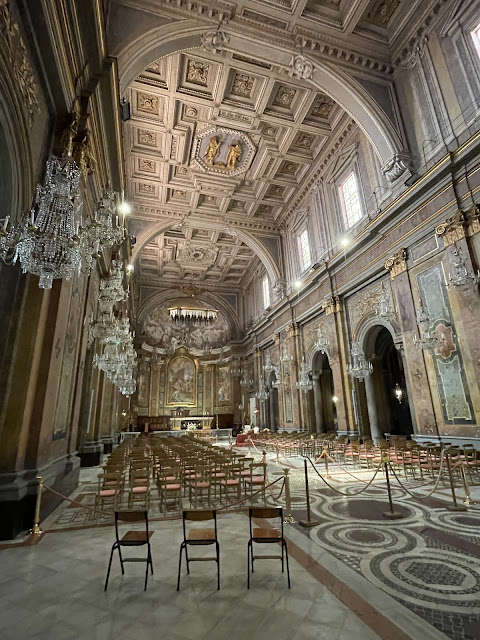The Triduum -- Holy Thursday to Easter -- A Solemn Procession
In seminary future priests live a relatively structured life. We don't live "by the bell" any more, but meal times are regular as are common prayer times. Once in a parish, however, structure can be left hanging on a thread. As a diocesan priest I am well-acquainted with the reality of being in a parish without other clergy handy. You have to go with the flow. Last Saturday was very much like that. I went from weekday morning Mass and confessions to our first of the First Communion Masses and then to a funeral, returning at four in the afternoon having started at eight in the morning. I had a couple hours to recuperate and then there was a social at the parish in the evening. Yesterday Masses finished at eight in the evening.
Holy Week and Easter, though we have many people, do provide a wonderful spiritual framework. Music and silence work together along with physical movement to convey the various stages of Christ's passion, death and resurrection.
On Palm Sunday, we began in the parish hall by proclaiming the Gospel text that recalls Christ's entry into Jerusalem. This is a joyous event and singing along with the procession with palm branches expresses it: "All Glory, Laud and Honour to thee Redeemer King . . . "
The antiphons that are interspersed during the proclamation of the Passion have a much more sombre mood: "Jesus, Remember me, when You come into Your Kingdom."
On Holy Thursday evening we celebrated the Mass of the Lord's Supper in the Parish. Again this begins as a joyful event. We received the blessed oils that had been brought from the celebration of the Chrism Mass at the cathedral on Tuesday: the Oil of Catechumens, the Oil of the Sick and the Oil of Sacred Chrism.
In the washing of the feet, we celebrate Jesus' commissioning of the apostles to proclaim the Good News through a life of service. But after Holy Communion the mood changes. Christ is about to be betrayed. The altar is stripped bare, the tabernacle is empty, candles are extinguished and a solemn procession with one vessel of Hosts is carried to a temporary chapel set up in the parish Hall. This represents the Garden of Gethsemane. Once the Eucharist is placed in the temporary tabernacle, the faithful are invited, like the apostles, to stay one hour with the Lord. The traditional chant of the "Pange Lingua" is used. And then SILENCE.
That silence is only briefly broken on Good Friday. The Liturgy on Good Friday is really a conglomeration of three things: the proclamation of the Passion according to John, the veneration (honouring) of the Cross (on which hung the Saviour of the world), and the distribution of Holy Communion. Again, the service begins and ends in silence. Once Communion is over the altar is again bare. There is one point of solemnity and of a kind of quiet joy. The saving reality of the Cross is used as the occasion to pray for its effectiveness in the world by a solemn series of prayers or invocations like the Prayers of the Faithful at regular Sunday Mass. These are ideally chanted including the responses. If a deacon is present, he chants the invitation to the assembled faithful and they respond: "For the sake of your Son, have mercy Lord."
The grand silence continues. Sacraments are not celebrated either on Good Friday or Holy Saturday. The Hosts distributed for Holy Communion on Good Friday are consecrated at the Mass of the Lord's Supper on Thursday night. In my current parish, this means consecrating approximately 8,000 hosts on Holy Thursday. The altar is full. Holy Saturday is a quiet day.
It is quiet, that is, until the Vigil. And the Vigil begins in darkness. A fire is lit outside and the Easter candle receives its light from that fire. Carrying the candle inside the darkened church the priest chants: "Christ, our Light." The people respond: "Thanks be to God!"
 Small candles representing the baptismal candles of those present are lit and our cantor sings the Easter proclamation, the Exsultet. Here is a link to an mp3: http://www3.canisius.edu/~moleski/exultet/exultet.mp3.
Small candles representing the baptismal candles of those present are lit and our cantor sings the Easter proclamation, the Exsultet. Here is a link to an mp3: http://www3.canisius.edu/~moleski/exultet/exultet.mp3.
Full orchestration, bells and vigorous choral singing reappear at the Gloria following the vigil of readings. The altar is dressed and the sacraments bubble up -- literally. We baptized or received into the Catholic Church 14 adults this year. We celebrated Baptism, Confirmation and they received their First Eucharist having spent the better part of a year preparing for this night.
All through Lent, the Church fasted from one word: Alleluia. Now, it is released and at the very end of the Mass it is repeated in a solemn chant: "Go in the peace of Christ, Alleluia, Alleluia! Thanks be to God, Alleluia! Alleluia.
In a non-liturgical note, it is usual that priests make themselves a a little bit scarce in the week following Easter to catch up on some much needed sleep and try to restore a little structure to their lives.
Holy Week and Easter, though we have many people, do provide a wonderful spiritual framework. Music and silence work together along with physical movement to convey the various stages of Christ's passion, death and resurrection.
On Palm Sunday, we began in the parish hall by proclaiming the Gospel text that recalls Christ's entry into Jerusalem. This is a joyous event and singing along with the procession with palm branches expresses it: "All Glory, Laud and Honour to thee Redeemer King . . . "
The antiphons that are interspersed during the proclamation of the Passion have a much more sombre mood: "Jesus, Remember me, when You come into Your Kingdom."
On Holy Thursday evening we celebrated the Mass of the Lord's Supper in the Parish. Again this begins as a joyful event. We received the blessed oils that had been brought from the celebration of the Chrism Mass at the cathedral on Tuesday: the Oil of Catechumens, the Oil of the Sick and the Oil of Sacred Chrism.
In the washing of the feet, we celebrate Jesus' commissioning of the apostles to proclaim the Good News through a life of service. But after Holy Communion the mood changes. Christ is about to be betrayed. The altar is stripped bare, the tabernacle is empty, candles are extinguished and a solemn procession with one vessel of Hosts is carried to a temporary chapel set up in the parish Hall. This represents the Garden of Gethsemane. Once the Eucharist is placed in the temporary tabernacle, the faithful are invited, like the apostles, to stay one hour with the Lord. The traditional chant of the "Pange Lingua" is used. And then SILENCE.
That silence is only briefly broken on Good Friday. The Liturgy on Good Friday is really a conglomeration of three things: the proclamation of the Passion according to John, the veneration (honouring) of the Cross (on which hung the Saviour of the world), and the distribution of Holy Communion. Again, the service begins and ends in silence. Once Communion is over the altar is again bare. There is one point of solemnity and of a kind of quiet joy. The saving reality of the Cross is used as the occasion to pray for its effectiveness in the world by a solemn series of prayers or invocations like the Prayers of the Faithful at regular Sunday Mass. These are ideally chanted including the responses. If a deacon is present, he chants the invitation to the assembled faithful and they respond: "For the sake of your Son, have mercy Lord."
The grand silence continues. Sacraments are not celebrated either on Good Friday or Holy Saturday. The Hosts distributed for Holy Communion on Good Friday are consecrated at the Mass of the Lord's Supper on Thursday night. In my current parish, this means consecrating approximately 8,000 hosts on Holy Thursday. The altar is full. Holy Saturday is a quiet day.
It is quiet, that is, until the Vigil. And the Vigil begins in darkness. A fire is lit outside and the Easter candle receives its light from that fire. Carrying the candle inside the darkened church the priest chants: "Christ, our Light." The people respond: "Thanks be to God!"
 Small candles representing the baptismal candles of those present are lit and our cantor sings the Easter proclamation, the Exsultet. Here is a link to an mp3: http://www3.canisius.edu/~moleski/exultet/exultet.mp3.
Small candles representing the baptismal candles of those present are lit and our cantor sings the Easter proclamation, the Exsultet. Here is a link to an mp3: http://www3.canisius.edu/~moleski/exultet/exultet.mp3.Full orchestration, bells and vigorous choral singing reappear at the Gloria following the vigil of readings. The altar is dressed and the sacraments bubble up -- literally. We baptized or received into the Catholic Church 14 adults this year. We celebrated Baptism, Confirmation and they received their First Eucharist having spent the better part of a year preparing for this night.
All through Lent, the Church fasted from one word: Alleluia. Now, it is released and at the very end of the Mass it is repeated in a solemn chant: "Go in the peace of Christ, Alleluia, Alleluia! Thanks be to God, Alleluia! Alleluia.
In a non-liturgical note, it is usual that priests make themselves a a little bit scarce in the week following Easter to catch up on some much needed sleep and try to restore a little structure to their lives.

